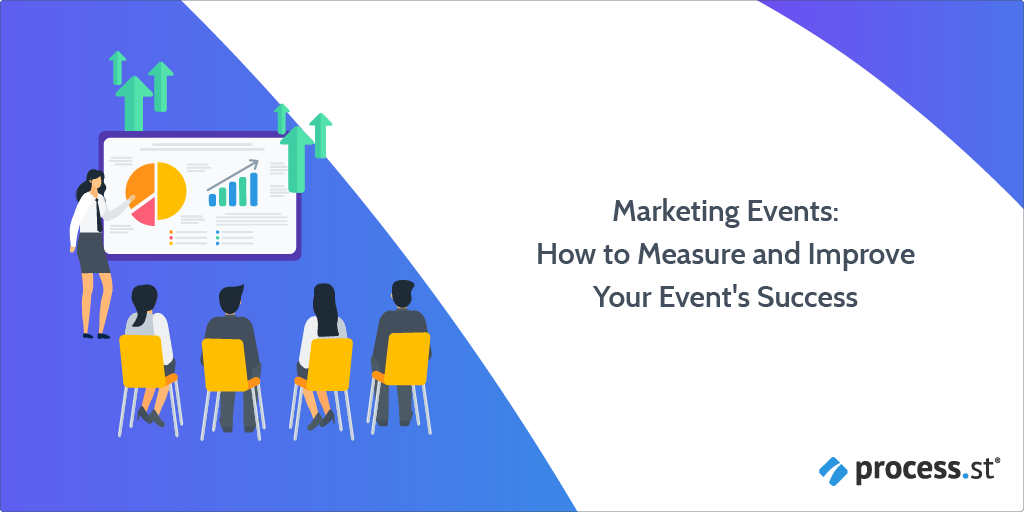
This is a guest post by Kristen McCabe, a global marketer. She has marketing experience extending from Australia to Chicago with expertise in both B2B and B2C industries, specializing in content, SEO, and events. Kristen spends her time outside of work acting, learning nature photography and joining in the #instadog fun with her Pug/JackRussell, Bella.
We have one reason marketers host and sponsor events.
Whether you want to get more leads, increase brand awareness, or meet with current customers to upsell and build customer lifetime value, marketing events ultimately leads to the same destination: increased revenue for a greater Return On Investment (ROI).
Despite this common goal, according to The Event Marketing Evolution, a research report by the Harvard Business Review, only 23% of companies can track event ROI.
Notice here that we say can rather than do track ROI, making these results even more concerning and surprising.
So our question to is this: How will you ensure you’re in the elite group of marketers who:
- Can track the success of their event sponsorship?
- Regularly track event results, and improve their strategy as needed?
In this Process Street article we will answer these two questions, and walk you through the steps that ensure you aren’t throwing your previous marketing dollars down the drain.
To start at the beginning, we find our selves before the day of the event.
With that, let’s not waste any more time, and get straight to it. Click on the subheaders below to jump to the relevant section. Alternatively, scroll down to read all.
- Event ROI: What it is and how to measure it
- Event planning: The pre-event strategy and planning stage
- Event partners: Your internal and external event partners
- Event ROI: Choosing an event that obtains a strong ROI, must-ask questions
- Event data: Capturing event data
- After the event: Measuring and building your success after the event
- Marketing events with Process Street
Event ROI: What it is and how to measure it
ROI is the ratio between net profit and the cost of investment. When marketing events, event ROI is the ratio between the net profit obtained from the event and the overall event cost.
Before moving forward it is important to cover the basics, and in this instance, those basics come from understanding event ROI.
As already mentioned, despite the common goal – to increase revenue for a greater ROI – only 23% of companies can track event ROI.
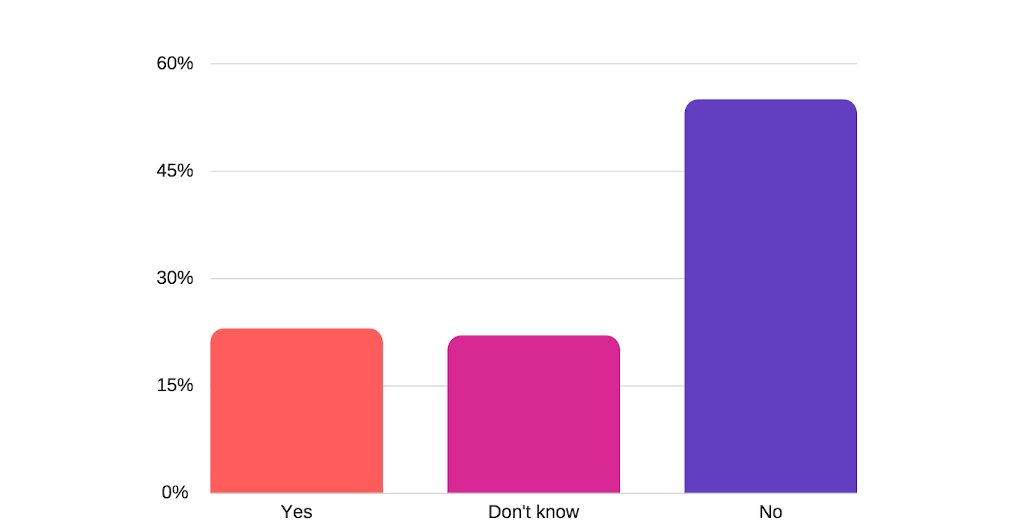
To be in the category of those marketers who can track event ROI, you need to know:
- The cost of your event
- The value of your event
This information can then be plugged into the following formula:
Event ROI = Event cost / Event value
Event planning: The pre-event strategy and planning
Event planning is part of event management, being the process of making the appropriate arrangements in advance. In this section, we focus on a pre-event strategy and planning.
To accurately measure event success, you need to have specific event elements in place. These are factors to be considered as soon as you sign that contract to book a venue or become an event sponsor/exhibitor – if not before!
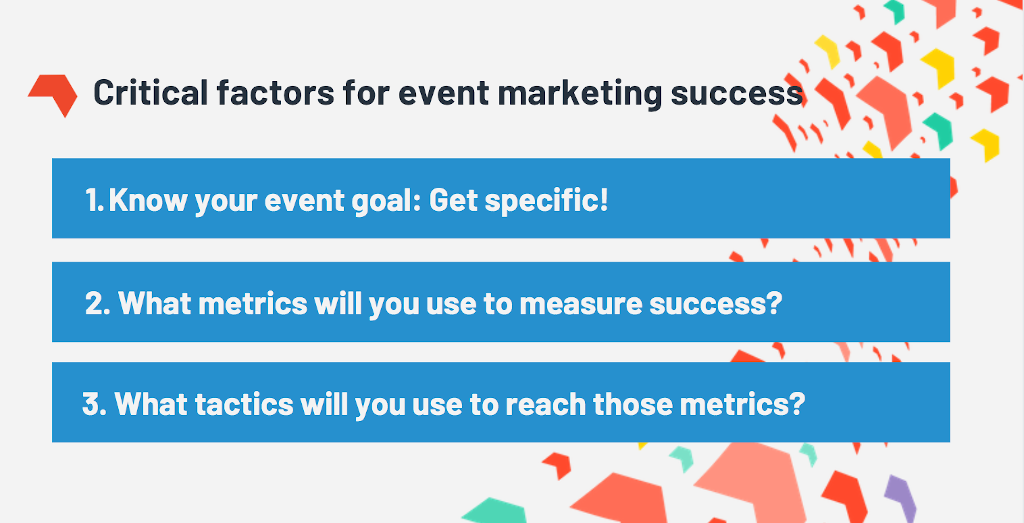
The elements we will discuss in this section are made up of two parts:
- The first is knowing your event goal
- The second is knowing how you’ll measure success towards that goal, and the tactics taken to reach it

Determine your event goal
To prove your event’s success, you need to know what success looks like – especially as marketing events bring benefits in many forms.
According to the 2018 CEIR Marketing Spend Decision Report, the top three reasons for trade show exhibition are: Lead generation (95%), brand awareness (94%), and meeting with customers (89%).
You need to know your goal before you commit to an event. If your company’s leadership has told you they want to move into event sponsorship, make sure you ask them: What do you want to achieve by sponsoring this event?
Remember to get specific with your goals. Are you expected to gather a certain number of leads from the event? If so, how many leads do you need? Alternatively, how many sales do you want to get, or how much pipeline do you intend to build?
Check out Process Street’s SMART Goal Setting Checklist detailed below. You can run this checklist anytime you need to set yourself a new event goal.
Click here to access our SMART Goal Setting Checklist for free
Measure success towards that goal, and the tactics taken to reach it
If you want to achieve brand awareness, you can measure success through the number of registrants with event ticketing and registration software.
If you’re new to this type of event marketing, look for event marketing groups on Facebook and LinkedIn. You’ll find many professionals happy to share their expertise on what is a reasonable goal.
Event partners: Your internal and external event partners
An event partner describes a mutually beneficial collaboration, with typically no financial exchange. In this section, we turn our attention to internal and external event partners.
When executing a B2B marketing strategy with a long sales cycle, you can’t forget about your partners in success.
Collaborating with co-workers at events
As yourself: Who at my company do I need to work with for this to be successful?
Who is going to be interacting with customers and prospects at your trade show booth? If it is your sales team, help them understand exactly what they need to do to ensure leads get in the system.
Many times, account executives have their own event goals. They need to meet with a certain number of clients and show the ROI they are getting from it.
If this is the case, and your sales team wants to have downtime between meetings, remind them that your marketing objectives are serving their pipeline. By engaging with prospects at the booth, they can reap the rewards when it comes to closed deals down the road.
Once you have them on board to work toward shared goals, you’ll need to train your team on how to do so. We’ll discuss this aspect more in a moment.
Training to gather event-day data

Whichever way you are gathering data, it’s critical to dedicate time to training your booth staff. Everyone at your booth – including your sales team, customer success team, teammates in marketing, and short-term temp staff (who know nothing about your brand) – must understand:
- What information they are responsible to gather, and
- How to gather that information
This leads to the next section of this article: training and incentivizing.
Once you know who you will be working with a booth, make sure they are trained in the relevant processes and procedures.
This step is essential to track your success. It’s easy for a customer success manager or salesperson to meet someone at your event, pocket their business card, and enter the prospect data into their CRM in their own time. This is one of the biggest challenges in tracking event ROI: When someone from the marketing team enters a new contact into the database, you have no control over an individual citing your event as the source of that lead.
It gets even trickier due to the nature of events. Having hosted, sponsored, and attended countless conferences, I can say with confidence: It’s easy for things to slip through the cracks.
Event ROI: Choosing an event that obtains a strong ROI, must-ask questions

To have a strong ROI, you must be strategic in choosing which event you sponsor, or what type of event you choose to host.
Have a mindset that focuses on data and analysis and bring this back to your event goal.
For example, say your primary goal is customer meetings. You want to increase renewals and upsell.
When a company reaches out and asks you to sponsor a conference, ask if information about those who attended last year’s event can be shared. If your primary goal is customer meetings, and if no customers are attending your event, chances are you won’t meet that goal.
Those working your sponsored event should want more than your money: They should want you to succeed. When you are the prospect, and a company is asking you to sponsor, ask the company to back the proposal with data, such as:
- What percentage of this year’s sponsors were at last year’s event?
- What is the company doing to ensure customers interact with sponsors? Is there a dedicated networking time in the expo hall?
- What place are attendees in their career – can they influence purchase decisions at their companies?
Once you understand the event structure and demographics, it’s time to see how the event management team will help you gather data:
- Will you get any attendee registration information before the conference?
- How can you track and engage with prospects through the event app?
- How will the event organizers send you leads, and how quickly will you get those leads?
- Can you integrate leads immediately into your CRM and marketing automation tactics?
Those leads often come from badge scanners. Start by making sure badge scanners will be provided, then follow up by asking:
- How many badge scanners will be provided at your sponsorship level?
- Can you rent extra scanners? If so, what is the cost?
- Does the event host give you badge scanners to capture leads? If so, how many?
- Does the host have back up scanners on hand in case of technical difficulties?
I’ve seen leads lost to the abyss when a booth is running short on lead scanners: Event delegates will not wait around for you to track down another device.
In the words of American author H. Jackson Brown Jr.,
“Nothing is more expensive than a missed opportunity.” – H. Jackson Brown
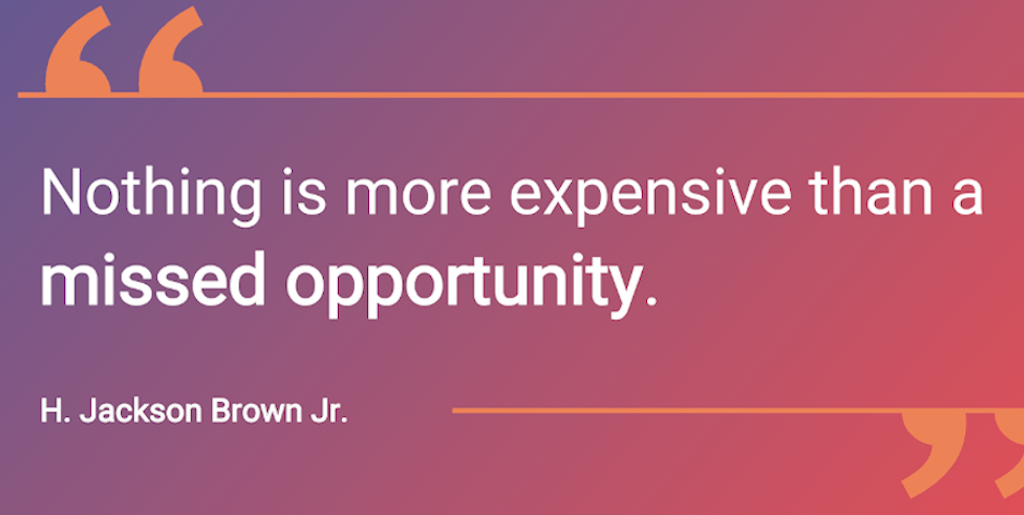
Even when you are working with an event organizer you love, and you’ve worked with them before, don’t make assumptions. Ensure these pieces will be in place for each event you sponsor.
Now that we’ve discussed leads and badge scanners, it’s time to delve deeper into some of the points mentioned above.
Event data: Capturing event data
Badge scanners are not the only method you can use to capture attendee information and measure your success.
We’ll walk through various ways you can not just capture event data, but get attendees ready and willing to share their details with you.
Note: Make sure you are aware of complying with all event marketing GDPR laws. Don’t use people’s data if you don’t have the legal right to it!
Email marketing

When it comes to events, many people think of an email marketing strategy as part of the post-event process. While this is true, if you have a list of registrants before the event, put yourself on their event schedule before it gets booked up.
When sending a pre-event email, be sure to do the following:
- Add recipients into your customer relationship management (CRM): By having all contacts in your CRM platform, you can immediately start measuring engagement and the effectiveness of event-related activities. This will also limit inaccuracies in your data.
- Personalize and segment your email: If you have existing customers and prospects, they can’t get the same email as new contacts. Give new contacts context into who your company is and what problem you can solve for them. Emails to existing accounts should come from their account manager.
- Build booth excitement: Why should attendees stop by your booth? Entice them with the opportunity for free swag or competitions. Remember, we’re all tuned in to the same radio station, WiiFM: What’s in it for me?
- Have a strong call to action (CTA): Make it clear exactly what you want email recipients to do. Whether it’s entering a competition or booking a meeting, create a CTA on your email that makes it easy for them to fulfill your request.
- Keep form fills short: If your button leads to a form, don’t ask for too many details. This is especially true for new contacts who don’t know your brand; you haven’t earned the trust to ask for their phone number yet. If you require that field and that trust isn’t there, you can wave that lead goodbye.
- Include your booth location: This is essential for conferences with thousands of people. How can you expect people to come to your booth if they don’t know where you are?
- Be transparent: I’ve had representatives email me to come to say hello at an event. Then, after searching high and low for their booth, I am told this company was not actually a sponsor, but just at the event. You can be sure that wasting my precious event time did not leave the best taste in my mouth.
The next two sections – lead forms and badge scanners – are more important when you don’t have attendee contact details.
Lead forms
Lead forms don’t only apply to pre-event emails.
Some marketers choose to capture leads on-site using lead forms.
If you’re going down this route, remember: When people give you their details, they expect something in return. Asking them to fill out a form means you’re asking for more of their time. This means you have to offer them something in return.
No one wants to fill out a form just to provide sale material!
Fun, interactive content increases the likelihood event delegates will pay the toll and fill out that lead form.
For example, create a quiz with questions tailored specifically towards your attendees. Christine Whelan, University of Wisconsin sociologist in the School of Human Ecology explains:
“People love it when you ask them questions about themselves. It makes us feel good that the quiz is interested in us.” – Christine Whelan, University of Wisconsin, Why Do You Love Personality Quizzes? Experts Break It Down
Whether you are doing quizzes, surveys, or polls, remember that popular word: FREE. In addition to quiz results, most people will want a freebie (even if it’s just chocolate or chapstick) in exchange for their names, titles, and email addresses.
Badge scanners
When you scan an attendee’s badge, you’ll receive the contact information they used when registering.
This data is more reliable than lead forms: No one is going to make up a phone number or email address when they’re invested in the event.
Badge scans are advantageous because they are quick – you aren’t holding attendees back from getting on to the next sponsor booth. At the same time, they’ll still want something in return.
What will you offer in-person to gather data and continue further engagement online?
Once again, you can give out event swag. However, why not embrace the opportunity to build your experiential marketing strategy? You’re already at an event!
I promise you, no one wants to be bored, even when it comes to corporate event planning.
Consider this example from TrackMaven, a sponsor at Content Marketing World, the annual conference run by the Content Marketing Institute.
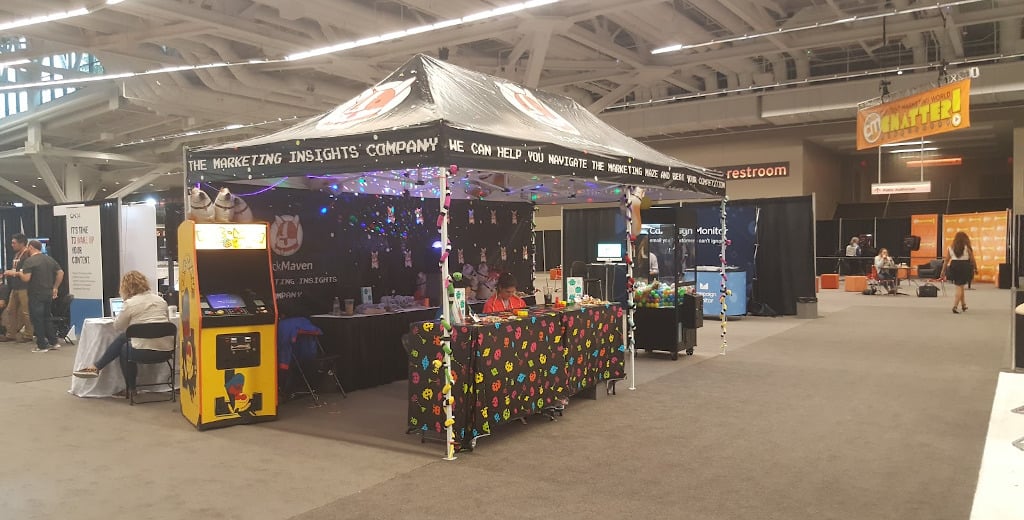
Your eyes aren’t deceiving you, that’s an old-school arcade game on the left and a claw-machine on the right.
Do you know when I took this picture? During a keynote address. The line for that claw machine was so long, that it was the only time I could take my turn to play! And, guess what? I did not mind in the slightest giving over a badge scan in exchange for unlimited attempts at that machine.
People are in a real-life event because they want real-life experiences. These interactions do more than get you that super-accurate badge-scanned data. They give you increased brand awareness and a way to measure that data.
How do you do that? Through social media, of course!
Social media interaction
Increased brand awareness at events can be hard to measure. Thankfully, the rise of social media has given you some advantages.
When you are successfully building brand awareness at events, people will want to talk about you. Take this tweet about the Track Maven booth pictured below:
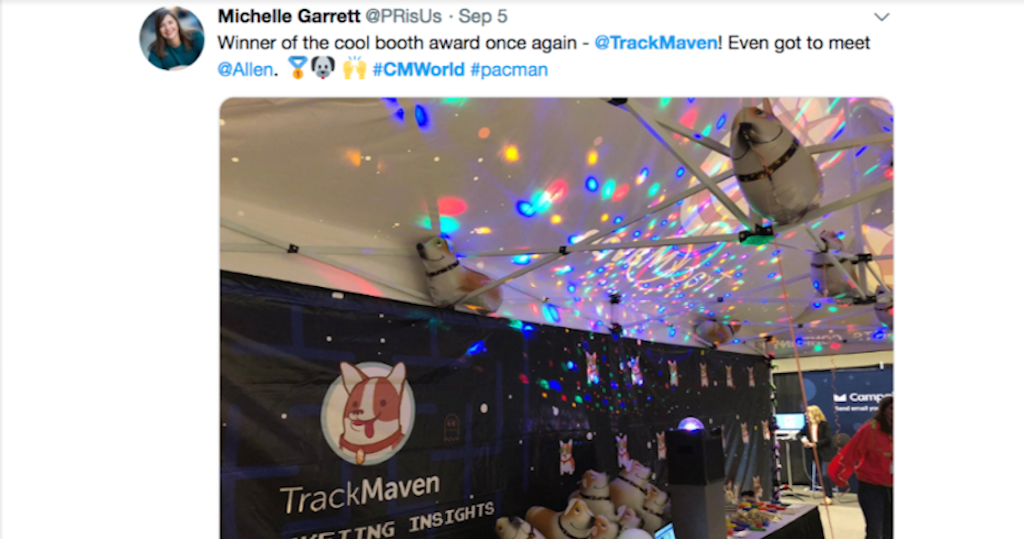
Take another example from the B2B Marketing Forum, run by MarketingProfs. This is an event I love but was unable to attend in 2018. So, I followed as closely as I could online.
Guess what: Even though I wasn’t at the event, I know – without a doubt – that Yesler was a sponsor, and it’s all thanks to its social media engagement.
Oh, and it might be partially thanks to a ball pit!
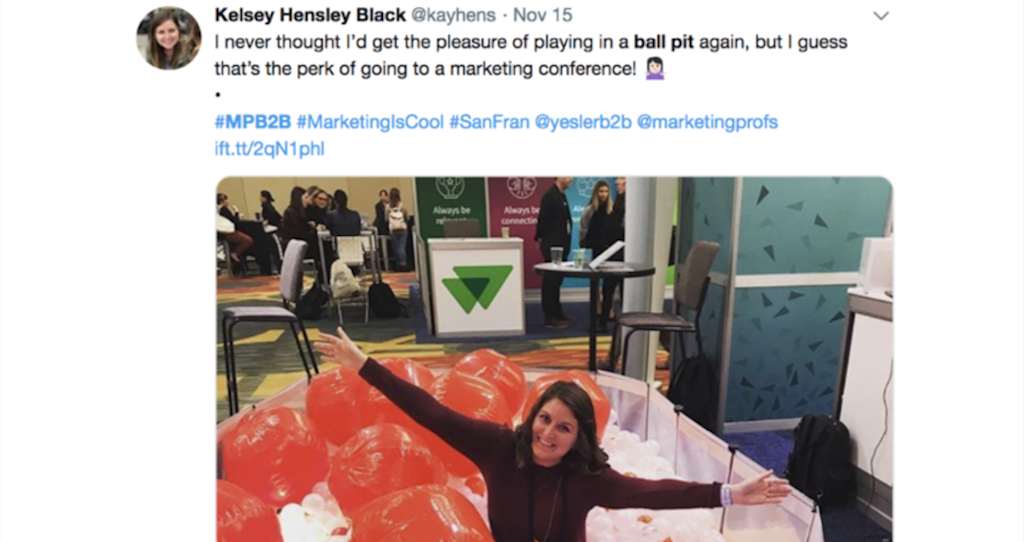
How you choose to track social media engagement is up to you.
Many social media engagement tools enable you to see the number of mentions, tags, likes, and shares. Looking at these metrics on event dates will give you a number you can measure.
Even without social media management software, consider assigning a point value to each type of engagement. For example, on Twitter:
- A like on your event post: 1 point
- Event post retweets: 2 points
- A comment on your event post: 3 points
- Attendees creating tweets that mention and/or tag you: 4 points
These metrics are all around you, you just need to find them.
Business cards
Despite living in the land of LinkedIn networking, people still carry around business cards at events.
Make sure that anyone working your booth keeps and compiles business cards to enter into your CRM software post-event. And, for a truly tried-but-true old-school way to track event success, have a pen and post-it notes handy.
If someone hands over their business card after a conversation, that’s an excellent indicator that they are a hot lead. Not only that, but this person is also a hot-lead you can attribute to your event!
Having those post-it notes ready means you and your team can write down notes from the conversation and stick them right on that card.
Want to know my biggest pet peeve? When I share a specific problem with an event sponsor, they say they’ll follow up, and I get an automated email. It doesn’t address my problems and was clearly a bulk send.
Collect and give all business cards to one person at the end of an event. Ensure it is a person who is well-trained on how to tag the lead to your event so you get the marketing attribution you deserve.
Want to gather even more business cards? You don’t need digital platforms for a good old-fashioned name-draw competition. Display the prize with a fishbowl sitting next to it, and watch the leads come dropping in. Be sure you don’t tag these attendees as a hot lead in your CRM.
Vanity URLs
When measuring brand awareness that you’ve earned through your event, consider using vanity URLs.
Whether it’s your event swag, postcards, or signage, create a custom URL that is:
- Short
- Easy to remember (avoid numbers)
- Related to your brand
If it’s not easy to type your URL into a mobile phone, you can forget people using it!
In addition to tracking all traffic that results from your vanity URL, measure organic and direct traffic during your event.
As you share your vanity URL, you can’t guarantee it will be used.
If traffic is a major company-wide goal, find other ways to attribute traffic to your sponsorship. Measure if site traffic during the event is elevated week-on-week and month-on-month.
Be ready to back yourself and prove you earned that traffic!
After the event: Measuring and building your success after the event

When looking at all of the measurement tactics mentioned above, it’s clear: Marketing channels are intertwined, especially at an event.
The same way you’re stitching together your process from pre-to-post event, you’re also creating the buyer’s journey for your prospect. None of these tactics occur in a vacuum. We now live in an age of omnichannel marketing.
You’ve already interacted with the lead in-person. Now it’s time to ensure you have captured those interactions in your database and continue nurturing ongoing relationships. Many attendees will interact with you on more than one channel.
The first step is to categorize your leads and tag them appropriately in your database. Have your sales and customer success teams do a one-on-one follow up with hot leads.
For new contacts – those who are higher in the sales funnel – send them materials that will make them want to interact with your brand. Then, be sure to measure that engagement: When you sent them a post-event email, did they take the action you hoped they would?
Once again, measure what your email’s CTA click-through rate was, whether that means visits to your website, e-book downloads, free trials, or any other marketing offer.
If you had a large team working your booth, send them a post-event survey. By doing so, you’ll discover any gaps in your event execution, and how to improve results at your next event.
Marketing events with Process Street
If you are new to Process Street and unsure about what it is we offer, check out the Monthly Webinar: An Introduction to Process Street:
.
Process Street is superpowered checklists.
With Process Street you can create any checklist as a means to manage your business operations. From calculating your event ROI, to event pre-planning, capturing event data and setting up relationships with event partners. Our checklists are dynamic, interactive machines, that making the management of your marketing events processes a breeze.
When creating your Process Street checklist – for free – you will find the following features:
- Stop tasks to ensure task order
- Dynamic due dates, so no deadline is missed
- Conditional logic, creating a dynamic template that caters to your needs
- Role assignments, to ease task delegation within your team
- Approvals, allowing decision-makers to give the go-ahead (or rejection) on important items. Also, necessary comments can be provided
For more information on how you can document your marketing event processes via a checklist in Process Street, watch the below video:
To help you get started I have detailed some of Process Street’s pre-made templates below that will assist you in your event marketing. If you check out our template library, you will find a pre-made templateS for almost any business process.
- AB Testing
- Buffer’s Social Media Etiquette Checklist
- Content Marketing Workflow Management Checklist Template
- Customer Feedback
- How to Market on Instagram – The Ultimate Guide
- Lead Nurturing Email Sequence Process
- New Facebook Ads Creation Checklist
- Performance Marketing (PPC) Keyword Competition Analysis Checklist
- Personalized marketing campaign template
- Re-engagement Sequence Email Process
- Remarket Leads In Gmail Template
- Sales Email Sequence Process
- Upsell Sequence Email Process
- Welcome Email Marketing Sequence, New Customer Process
Use Process Street to manage and measure your event data
Anyone who has participated in event marketing will tell you: It’s a lot of work. In the event-planning process, you can’t let tight deadlines for booth designs and shipments get in the way of what matters: revenue.
Determine what your specific goal is and look for any and every opportunity to track it. If you fall short of your goal, look for the lessons: Is it the goal that needs adjustment or your execution? Or, does it simply come down to the all-too-common truth that you haven’t correctly tracked and attributed your event data?
Don’t let a successful event look like a failure because you didn’t get the credit you deserve. Take the time to implement your event tracking measures. I promise you will thank yourself later! (and your boss will too!)
Sign up to Process Street for free and start documenting, managing and measuring your marketing event processes.
What problems have you faced with marketing events? What strategies have you found to be effective? Please comment below as we would love to hear from you. Who knows, you may even get featured in an upcoming article.







 Workflows
Workflows Forms
Forms Data Sets
Data Sets Pages
Pages Process AI
Process AI Automations
Automations Analytics
Analytics Apps
Apps Integrations
Integrations
 Property management
Property management
 Customer management
Customer management
 Human resources
Human resources
 Information technology
Information technology



Jane Courtnell
Hi there, I am a Junior Content Writer at Process Street. I graduated in Biology, specializing in Environmental Science at Imperial College London. During my degree, I developed an enthusiasm for writing to communicate environmental issues. I continued my studies at Imperial College's Business School, and with this, my writing progressed looking at sustainability in a business sense. When I am not writing I enjoy being in the mountains, running and rock climbing. Follow me at @JaneCourtnell.